Effective Combined Photodynamic Therapy with Lipid Platinum Chloride Nanoparticles Therapies of Oral Squamous Carcinoma Tumor Inhibition
Abstract
1. Introduction
2. Experimental Section
2.1. Materials
2.2. PDT Light Source
2.3. Formulation of LPC NPs
2.4. Characterization of LPC NPs
2.5. Cell Culture
2.6. Establishment of OSCC Xenograft Animal Model and Treatment Design
2.7. In Vitro Cell Viability
2.8. Western Blot Analysis
2.9. H&E and IHC Staining
2.10. TUNEL Assay
2.11. In Vivo Toxicity Assay
2.12. Statistical Analysis
3. Results
3.1. Characterization of LPC NPs
3.2. LPC NPs Significantly Enhanced Oral Cancer Cell Death in Vitro
3.3. In Vivo Therapeutic Outcome of Combined PDT and LPC NPs
3.4. In Vivo Toxicity Assay
4. Discussion
5. Conclusions
Supplementary Materials
Author Contributions
Funding
Acknowledgments
Conflicts of Interest
References
- Wang, D.; Lippard, S.J. Cellular processing of platinum anticancer drugs. Nat. Rev. Drug Discov. 2005, 4, 307–320. [Google Scholar] [CrossRef]
- Enoiu, M.; Jiricny, J.; Scharer, O.D. Repair of cisplatin-induced DNA interstrand crosslinks by a replication-independent pathway involving transcription-coupled repair and translesion synthesis. Nucleic Acids Res. 2012, 40, 8953–8964. [Google Scholar] [CrossRef]
- Babu, A.; Amreddy, N.; Ramesh, R. Nanoparticle-based cisplatin therapy for cancer. Ther. Deliv. 2015, 6, 115–119. [Google Scholar] [CrossRef]
- Wheate, N.J.; Walker, S.; Craig, G.E.; Oun, R. The status of platinum anticancer drugs in the clinic and in clinical trials. Dalton Trans. 2010, 39, 8113–8127. [Google Scholar] [CrossRef] [PubMed]
- Decatris, M.P.; Sundar, S.; O’Byrne, K.J. Platinum-based chemotherapy in metastatic breast cancer: Current status. Cancer Treat. Rev. 2004, 30, 53–81. [Google Scholar] [CrossRef]
- Raina, V.; Kunjahari, M.; Shukla, N.K.; Deo, S.V.; Sharma, A.; Mohanti, B.K.; Sharma, D.N. Outcome of combined modality treatment including neoadjuvant chemotherapy of 128 cases of locally advanced breast cancer: Data from a tertiary cancer center in northern India. Indian J. Cancer 2011, 48, 80–85. [Google Scholar] [CrossRef] [PubMed]
- Rubin, P.; Carter, S.K. Combination radiation therapy and chemotherapy: A logical basis for their clinical use. CA A Cancer J. Clin. 1976, 26, 274–292. [Google Scholar] [CrossRef] [PubMed]
- Hsu, Y.C.; Yang, D.F.; Chiang, C.P.; Lee, J.W.; Tseng, M.K. Successful treatment of 7,12-dimethylbenz(a)anthracene-induced hamster buccal pouch precancerous lesions by topical 5-aminolevulinic acid-mediated photodynamic therapy. Photodiagnosis Photodyn. Ther. 2012, 9, 310–318. [Google Scholar] [CrossRef]
- Ascencio, M.; Collinet, P.; Cosson, M.; Vinatier, D.; Mordon, S. The place of photodynamic therapy in gynecology. Gynecol. Obstet. Fertil. 2007, 35, 1155–1165. [Google Scholar] [CrossRef]
- Mang, T.S.; Allison, R.; Hewson, G.; Snider, W.; Moskowitz, R. A phase II/III clinical study of tin ethyl etiopurpurin (Purlytin)-induced photodynamic therapy for the treatment of recurrent cutaneous metastatic breast cancer. Cancer J. Sci. Am. 1998, 4, 378–384. [Google Scholar]
- Biel, M. Advances in photodynamic therapy for the treatment of head and neck cancers. Off. J. Am. Soc. Laser Med. Surg. 2006, 38, 349–355. [Google Scholar] [CrossRef] [PubMed]
- Castano, A.P.; Demidova, T.N.; Hamblin, M.R. Mechanisms in photodynamic therapy: Part one-photosensitizers, photochemistry and cellular localization. Photodiagnosis Photodyn. Ther. 2004, 4, 279–293. [Google Scholar] [CrossRef]
- Master, A.; Livingston, M.S.; Gupta, A. Photodynamic nanomedicine in the treatment of solid tumors: Perspectives and challenges. J. Control. Release 2013, 168, 88–102. [Google Scholar] [CrossRef] [PubMed]
- Snyder, J.W.; Greco, W.R.; Bellnier, D.A.; Vaughan, L.; Henderson, B.W. Photodynamic therapy: A means to enhanced drug delivery to tumors. Cancer Res. 2003, 63, 8126–8131. [Google Scholar] [PubMed]
- Chen, B.; Pogue, B.W.; Luna, J.M.; Hardman, R.L.; Hoopes, P.J. Tumor vascular permeabilization by vascular-targeting photosensitization: Effects, mechanism, and therapeutic implications. Clin. Cancer Res. 2006, 12, 917–923. [Google Scholar] [CrossRef] [PubMed]
- Gil, M.; Bieniasz, M.; Seshadri, M.; Fisher, D.; Ciesielski, M.J.; Chen, Y.; Pandey, R.K.; Kozbor, D. Photodynamic therapy augments the efficacy of oncolytic vaccinia virus against primary and metastatic tumours in mice. Br. J. Cancer 2011, 105, 1512–1521. [Google Scholar] [CrossRef]
- Vrouenraets, M.B.; Visser, G.W.; Snow, G.B.; van Dongen, G.A. Basic principles, applications in oncology and improved selectivity of photodynamic therapy. Anticancer Res. 2003, 23, 505–522. [Google Scholar]
- Guo, S.; Miao, L.; Wang, Y.; Huang, L. Unmodified drug used as a material to construct nanoparticles: Delivery of cisplatin for enhanced anti-cancer therapy. J. Control. Release 2014, 174, 137–142. [Google Scholar] [CrossRef]
- Eka Putra, G.N.P.; Huang, L.; Hsu, Y.C. Cisplatin encapsulated nanoparticle as a therapeutic agent for anticancer treatment. In Proceedings of the SPIE 9709, Biophotonics and Immune Responses XI, San Francisco, CA, USA, 9 March 2016. 97090T. [Google Scholar]
- Guo, S.; Wang, Y.; Miao, L.; Xu, Z.; Lin, C.H.; Huang, L. Turning a water and oil insoluble cisplatin derivative into a nanoparticle formulation for cancer therapy. Biomaterials 2014, 35, 7647–7653. [Google Scholar] [CrossRef]
- Guo, S.; Wang, Y.; Miao, L.; Xu, Z.; Lin, C.M.; Zhang, Y.; Huang, L. Lipid-coated Cisplatin nanoparticles induce neighboring effect and exhibit enhanced anticancer efficacy. ACS Nano 2013, 7, 9896–9904. [Google Scholar] [CrossRef]
- Sano, K.; Nakajima, T.; Choyke, P.L.; Kobayashi, H. Markedly enhanced permeability and retention effects induced by photo-immunotherapy of tumors. ACS Nano 2013, 7, 717–724. [Google Scholar] [CrossRef] [PubMed]
- Chen, W.H.; Lecaros, R.L.; Tseng, Y.C.; Huang, L.; Hsu, Y.C. Nanoparticle delivery of HIF1alpha siRNA combined with photodynamic therapy as a potential treatment strategy for head-and-neck cancer. Cancer Lett. 2015, 359, 65–74. [Google Scholar] [CrossRef] [PubMed]
- Lecaros, R.L.; Huang, L.; Lee, T.C.; Hsu, Y.C. Nanoparticle Delivered VEGF-A siRNA Enhances Photodynamic Therapy for Head and Neck Cancer Treatment. Mol. Ther. 2016, 24, 106–116. [Google Scholar] [CrossRef] [PubMed]
- Banerjee, R.; Tyagi, P.; Li, S.; Huang, L. Anisamide-targeted stealth liposomes: A potent carrier for targeting doxorubicin to human prostate cancer cells. Int. J. Cancer 2004, 112, 693–700. [Google Scholar] [CrossRef] [PubMed]
- Varkouhi, A.K.; Scholte, M.; Storm, G.; Haisma, H.J. Endosomal escape pathways for delivery of biologicals. J. Control. Release 2011, 151, 220–228. [Google Scholar] [CrossRef] [PubMed]
- Zhu, Y.; Meng, T.; Tan, Y.; Yang, X.; Liu, Y.; Liu, X.; Yu, F.; Wen, L.; Dai, S.; Yuan, H.; et al. Negative Surface Shielded Polymeric Micelles with Colloidal Stability for Intracellular Endosomal/Lysosomal Escape. Mol. Pharm. 2018, 15, 5374–5386. [Google Scholar] [CrossRef] [PubMed]
- Zhou, K.; Wang, Y.; Huang, X.; Lubyphelps, K.; Sumer, B.D.; Gao, J. Tunable, Ultrasensitive Ph-Responsive Nanoparticles Targeting Specific Endocytic Organelles in Living Cells. Angew. Chem. Int. Ed. 2011, 50, 6109–6114. [Google Scholar] [CrossRef]
- Maxfield, F.R.; McGraw, T.E. Endocytic Recycling. Nat. Rev. Mol. Cell Biol. 2004, 5, 121–132. [Google Scholar] [CrossRef]
- Sedlacek, M.; Dimaano, F.; Uribarri, J. Relationship between phosphorus and creatinine clearance in peritoneal dialysis: Clinical implications. Am. J. Kidney Dis. 2000, 36, 1020–1024. [Google Scholar] [CrossRef]
- Wang, Z.; Ma, R.; Yan, L.; Chen, X.; Zhu, G. Combined chemotherapy and photodynamic therapy using a nanohybrid based on layered double hydroxides to conquer cisplatin resistance. Chem. Commun. 2015, 51, 11587–11590. [Google Scholar] [CrossRef]
- He, C.; Liu, D.; Lin, W. Self-assembled core-shell nanoparticles for combined chemotherapy and photodynamic therapy of resistant head and neck cancers. ACS Nano 2015, 9, 991–1003. [Google Scholar] [CrossRef] [PubMed]
- Zhou, L.; Wei, S.H.; Ge, X.F.; Zhou, J.H.; Jiang, H.J.; Li, F.Y.; Shen, J. Combination of chemotherapy and photodynamic therapy using graphene oxide as drug delivery system. J. Photochem. Photobiol. B Biol. 2014, 135, 7–16. [Google Scholar] [CrossRef] [PubMed]
- Chen, Y.; Gao, Y.; Wang, K.; Zhu, J. Synergistic chemo-photodynamic therapy mediated by light-activated ROS-degradable nanocarriers. J. Mater. Chem. B 2019, 7, 460–468. [Google Scholar] [CrossRef]
- Siddik, Z. Cisplatin: Mode of cytotoxic action and molecular basis of resistance. Oncogene 2003, 22, 7265–7279. [Google Scholar] [CrossRef]
- Batchelor, E.; Loewer, A.; Lahav, G. The ups and downs of p53: Understanding protein dynamics in single cells. Nat. Rev. Cancer 2009, 9, 371–377. [Google Scholar] [CrossRef]
- Paek, A.L.; Liu, J.C.; Loewer, A.; Forrester, W.C.; Lahav, G. Cell-to-Cell Variation in p53 Dynamics Leads to Fractional Killing. Cell 2016, 165, 631–642. [Google Scholar] [CrossRef]
- Reyes, J.; Chen, J.Y.; Stewart-Ornstein, J.; Karhohs, K.W.; Mock, C.S.; Lahav, G. Fluctuations in p53 Signaling Allow Escape from Cell-Cycle Arrest. Mol. Cell 2018, 71, 581–591. [Google Scholar] [CrossRef]
- Durlacher-Betzer, K.; Hassan, A.; Levi, R.; Axelrod, J.; Silver, J.; Naveh-Many, T. Interleukin-6 contributes to the increase in fibroblast growth factor 23 expression in acute and chronic kidney disease. Kidney Int. 2018, 94, 315–325. [Google Scholar] [CrossRef]
- Kim, H.J.; Oh, G.S.; Lee, J.H.; Lyu, A.R.; Ji, H.M.; Lee, S.H.; Song, J.; Park, S.J.; You, Y.O.; Sul, J.D.; et al. Cisplatin ototoxicity involves cytokines and STAT6 signaling network. Cell Res. 2011, 21, 944–956. [Google Scholar] [CrossRef]
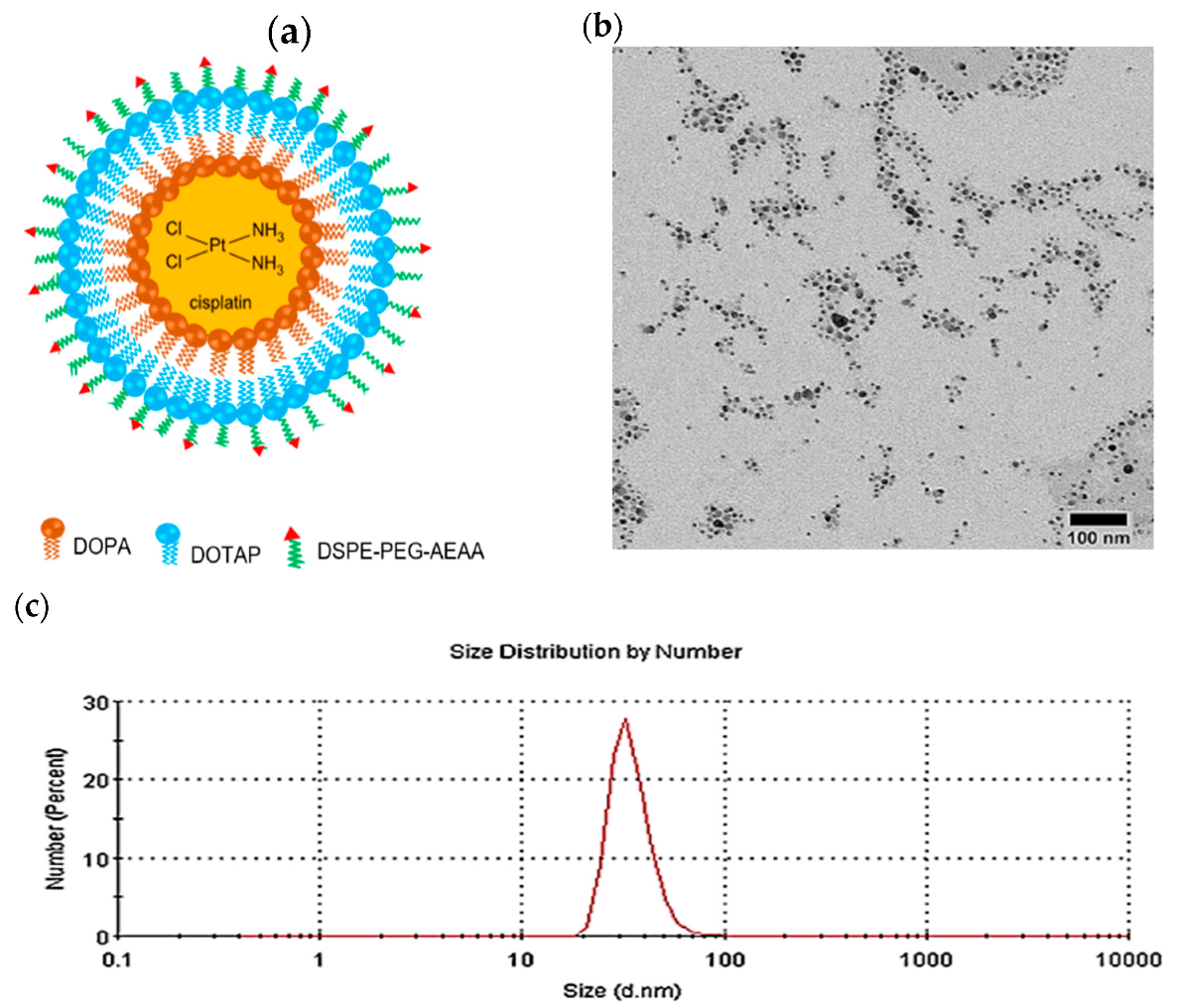
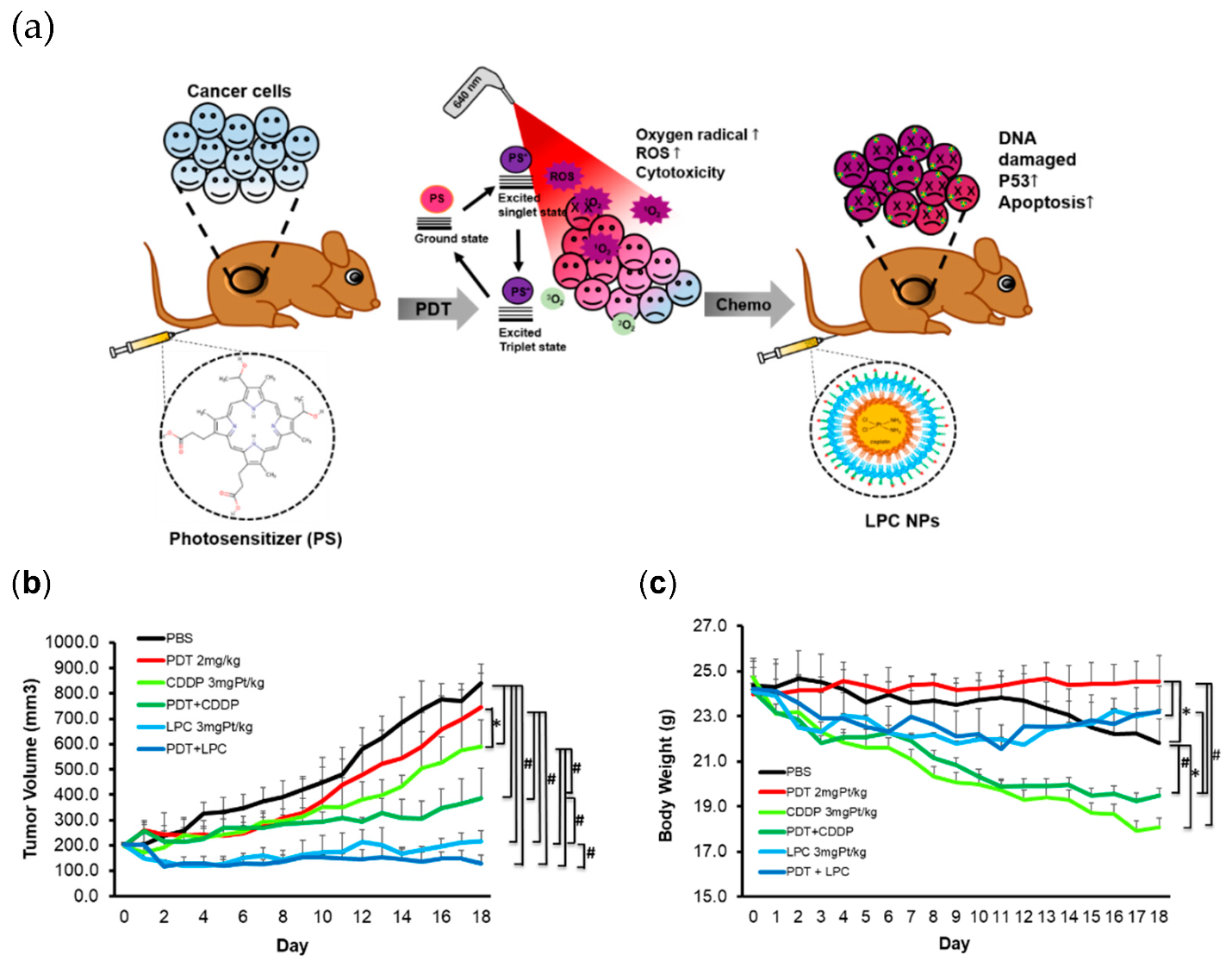
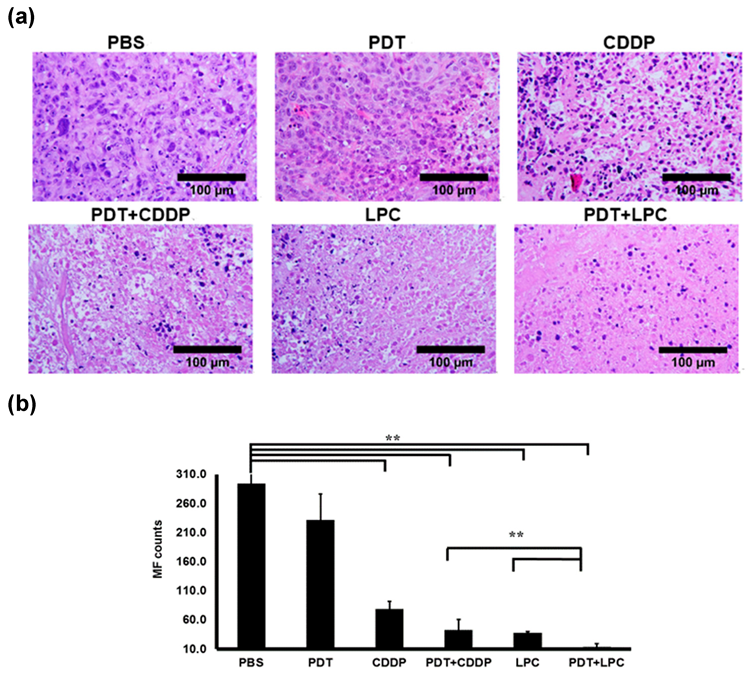
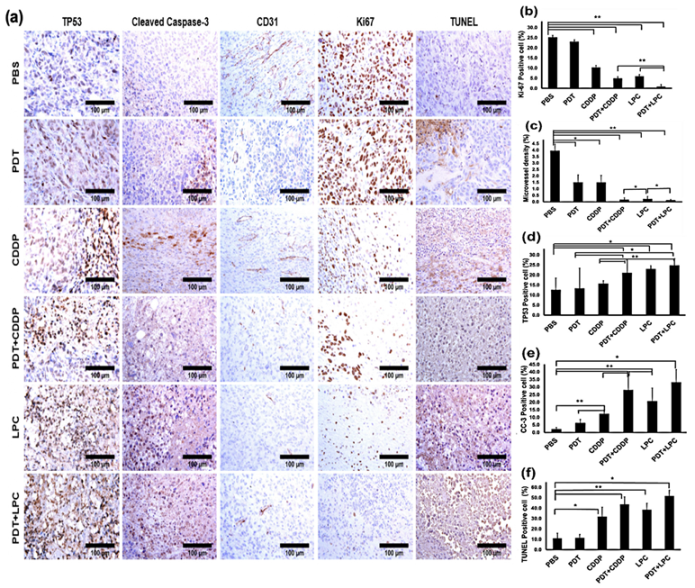
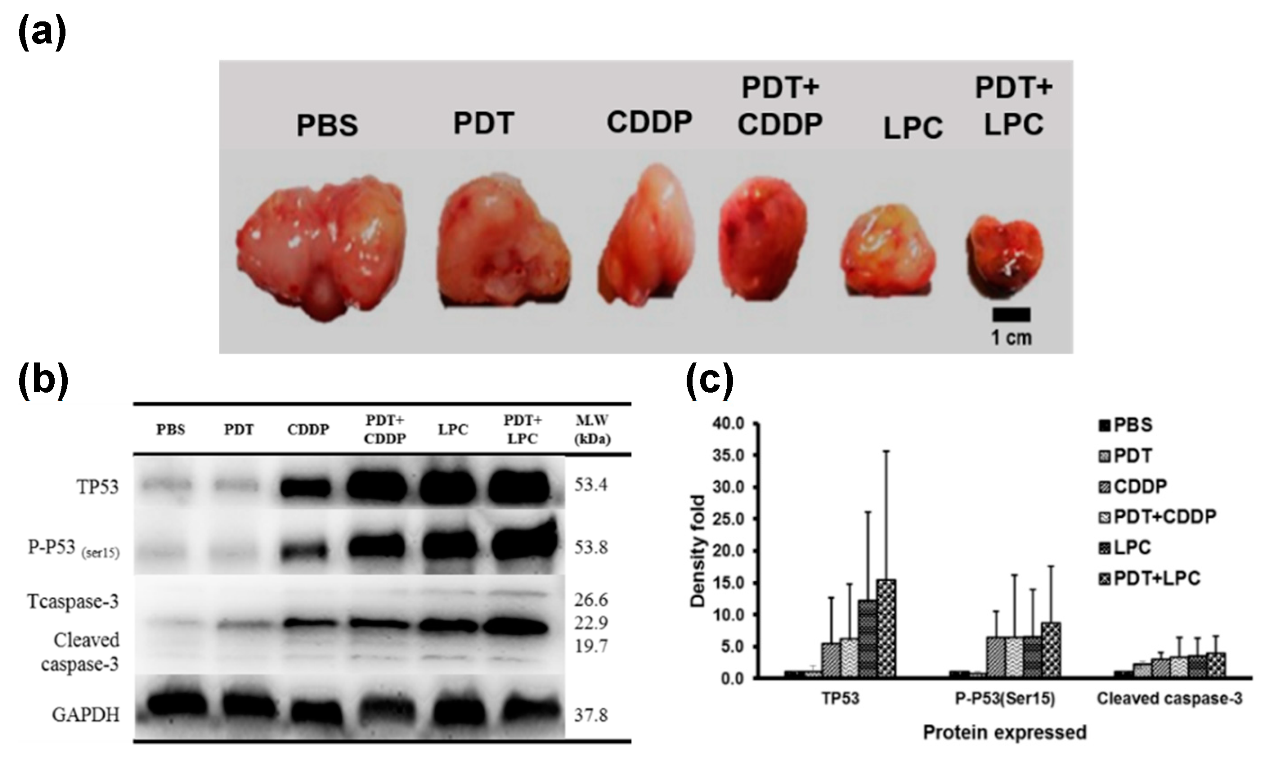
| Run | Size (nm) | PDI | Zeta potential (mV) | %Drug Loading |
|---|---|---|---|---|
| 1 | 34.94 | 0.48 | 47.40 | 89.32 |
| 2 | 34.22 | 0.48 | 47.10 | 90.92 |
| 3 | 35.81 | 0.41 | 46.70 | 88.51 |
| Mean a | 35.0 ± 0.8 | 0.4 ± 0.1 | 47.1 ± 0.4 | 89.6 ± 4.4 |
| Group | AST (U/L) | ALT (U/L) | BUN (mg/dL) | Phosphorus (mg/dL) | Calcium (mg/dL) | IL-6 (pg/mL) | IL-12 (pg/mL) | INF-γ (pg/mL) |
|---|---|---|---|---|---|---|---|---|
| PBS | 56.9 ± 6.8 | 23.3 ± 3.1 | 35.4 ± 1.6 | 4.9 ± 1.2 | 9.7 ± 0.3 | 650.7 ± 54.7 | 180.1 ± 24.9 | 100.2 ± 37.5 |
| CDDP | 124.7 ± 35.0 * | 29.9 ± 7.2 | 40.5 ± 5.9 | 8.1 ± 2.3 | 10.5 ± 0.4 | 683.4 ± 81.6 | 240.6 ± 29.4 | 91.1 ± 32.5 |
| LPC NPs | 90.1 ± 46.4 | 30.7 ± 3.8 | 38.0 ± 4.5 | 5.9 ± 2.6 | 10.1 ± 0.9 | 603.7 ± 67.3 | 166.1 ± 12.9 | 90.7 ± 15.1 |
© 2019 by the authors. Licensee MDPI, Basel, Switzerland. This article is an open access article distributed under the terms and conditions of the Creative Commons Attribution (CC BY) license (http://creativecommons.org/licenses/by/4.0/).
Share and Cite
Gusti-Ngurah-Putu, E.-P.; Huang, L.; Hsu, Y.-C. Effective Combined Photodynamic Therapy with Lipid Platinum Chloride Nanoparticles Therapies of Oral Squamous Carcinoma Tumor Inhibition. J. Clin. Med. 2019, 8, 2112. https://doi.org/10.3390/jcm8122112
Gusti-Ngurah-Putu E-P, Huang L, Hsu Y-C. Effective Combined Photodynamic Therapy with Lipid Platinum Chloride Nanoparticles Therapies of Oral Squamous Carcinoma Tumor Inhibition. Journal of Clinical Medicine. 2019; 8(12):2112. https://doi.org/10.3390/jcm8122112
Chicago/Turabian StyleGusti-Ngurah-Putu, Eka-Putra, Leaf Huang, and Yih-Chih Hsu. 2019. "Effective Combined Photodynamic Therapy with Lipid Platinum Chloride Nanoparticles Therapies of Oral Squamous Carcinoma Tumor Inhibition" Journal of Clinical Medicine 8, no. 12: 2112. https://doi.org/10.3390/jcm8122112
APA StyleGusti-Ngurah-Putu, E.-P., Huang, L., & Hsu, Y.-C. (2019). Effective Combined Photodynamic Therapy with Lipid Platinum Chloride Nanoparticles Therapies of Oral Squamous Carcinoma Tumor Inhibition. Journal of Clinical Medicine, 8(12), 2112. https://doi.org/10.3390/jcm8122112







